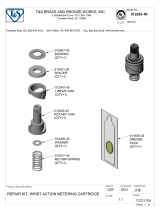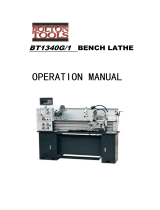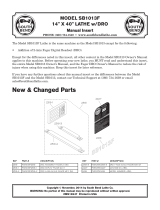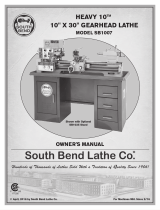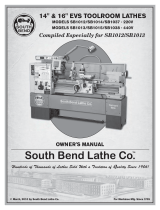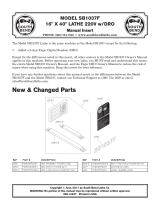Page is loading ...

Operation and Maintenance Instructions
Belt Drive Bench Lathe, 13x40-inch
Model BDB-1340A
(shown with optional 321443AK stand)
For Parts List and Electrical Diagrams, see document M-321357A
JET
427 New Sanford Road
LaVergne, Tennessee 37086 Part No. M-321360A
Ph.: 800-274-6848 Revision H1 08/2018
www.jettools.com Copyright © 2014 JET
This .pdf document is bookmarked

2
1.0 IMPORTANT SAFETY
INSTRUCTIONS
WARNING - To reduce risk of injury:
1. Read and understand the entire contents of
this manual before attempting assembly or
operation.
2. Read and understand the warnings posted on
the machine and in this manual. Failure to
comply with all of these warnings may cause
serious injury.
3. This manual is intended to familiarize you with
the technical aspects of this lathe. It is not, nor
was it intended to be, a training manual.
4. This machine is designed and intended for use
by properly trained and experienced personnel
only. If you are not familiar with the proper and
safe operation of a lathe, do not use until
proper training and knowledge have been
obtained.
5. Always wear approved safety glasses/face
shields while using this lathe. Everyday
eyeglasses only have impact resistant lenses;
they are not safety glasses.
6. Wear proper apparel. Remove tie, rings,
watches and other jewelry, and roll sleeves up
past the elbows. Remove all loose clothing and
confine long hair. Non-slip footwear or anti-skid
floor strips are recommended. Do not wear
gloves.
7. Wear ear protectors (plugs or muffs) during
extended periods of operation.
8. Do not operate this machine while tired or
under the influence of drugs, alcohol or any
medication.
9. Make certain the switch is in the OFF position
before connecting the machine to the power
supply.
10. Make certain the machine is properly grounded.
11. Do not place hands near the chuck while the
machine is operating.
12. Make all machine adjustments or maintenance
with the machine unplugged from the power
source.
13. Remove adjusting keys and wrenches. Form a
habit of checking to see that keys and adjusting
wrenches are removed from the machine
before turning it on.
14. Keep safety guards in place at all times when
the machine is in use. If removed for
maintenance purposes, use extreme caution
and replace the guards immediately after
maintenance is complete.
15. Check damaged parts. Check for alignment of
moving parts, binding of moving parts, breakage
of parts, mounting and any other conditions that
may affect its operation. A guard or other part
that is damaged should be properly repaired or
replaced.
16. Keep the floor around the machine clean and
free of scrap material, oil and grease.
17. Keep visitors a safe distance from the work
area. Keep children away.
18. Make your workshop child proof with padlocks,
master switches or by removing starter keys.
19. Give your work undivided attention. Looking
around, carrying on a conversation and “horse-
play” are careless acts that can result in serious
injury.
20. Do not overreach. Keep proper footing and
balance at all times.
21. Use the right tool. Do not force a tool or
attachment to do a job for which it was not
designed. The right tool will do the job better and
safer.
22. Use recommended accessories; improper
accessories may be hazardous.
23. Maintain tools with care. Keep tools sharp and
clean for the best and safest performance.
Follow instructions for lubricating and changing
accessories.
24. Turn off the machine and disconnect from power
before cleaning. Use a brush or compressed air
to remove chips or debris — do not use your
hands.
25. Never leave the machine running unattended.
Turn the power off and do not leave the machine
until it comes to a complete stop.
26. Remove loose items and unnecessary work
pieces from the area before starting the
machine.
WARNING: This product can expose you to
chemicals including lead and cadmium which are
known to the State of California to cause cancer
and birth defects or other reproductive harm, and
phthalates which are known to the State of
California to cause birth defects or other
reproductive harm. For more information go to
http://www.p65warnings. ca.gov.

3
Familiarize yourself with the following safety notices used in this manual:
This means that if precautions are not heeded, it may result in minor injury and/or possible
machine damage.
This means that if precautions are not heeded, it may result in serious injury or possibly even
death.
WARNING: Some dust, fumes and gases
created by power sanding, sawing, grinding,
drilling, welding and other construction activities
contain chemicals known to the State of
California to cause cancer and birth defects or
other reproductive harm. Some examples of
these chemicals are:
• lead from lead based paint
• crystalline silica from bricks, cement and
other masonry products
• arsenic and chromium from chemically
treated lumber
Your risk of exposure varies, depending on how
often you do this type of work. To reduce your
exposure to these chemicals, work in a well-
ventilated area and work with approved safety
equipment, such as dust masks that are
specifically designed to filter out microscopic
particles. For more information go to
http://www.p65warnings.ca.gov/ and http://www.
p65warnings.ca.gov/wood.

4
2.0 Table of Contents
1.0 IMPORTANT SAFETY INSTRUCTIONS ............................................................................................... 2
2.0 Table of Contents ................................................................................................................................... 4
3.0 Specifications ......................................................................................................................................... 5
4.0 Dimensions of optional stand (p/n 321443AK) ...................................................................................... 6
5.0 Assembly ................................................................................................................................................ 6
5.1 Contents of shipping container ........................................................................................................... 6
5.2 Uncrating and Clean-Up ..................................................................................................................... 7
5.3 Chuck Preparation (Three Jaw) ......................................................................................................... 8
5.4 Lubrication .......................................................................................................................................... 9
6.0 Electrical Connections.......................................................................................................................... 11
7.0 General Description ............................................................................................................................. 11
8.0 Controls ................................................................................................................................................ 13
9.0 Adjustments ......................................................................................................................................... 15
9.1 Break-In Procedure .......................................................................................................................... 15
9.2 Speed Selection ............................................................................................................................... 15
9.3 Feed and Thread Selection .............................................................................................................. 15
9.4 Change Gear Replacement .............................................................................................................. 16
9.5 Thread Cutting .................................................................................................................................. 16
9.6 Thread and Feed Chart .................................................................................................................... 17
9.7 Automatic Feed Operation and Feed Changes ................................................................................ 19
9.8 Powered Carriage Travel ................................................................................................................. 19
9.9 Saddle Adjustment ........................................................................................................................... 19
9.10 Cross Slide Adjustment .................................................................................................................. 19
9.11 Compound Rest Adjustment ........................................................................................................... 20
9.12 Tailstock Adjustment ...................................................................................................................... 20
9.13 Half Nut Gib Adjustment ................................................................................................................. 20
9.14 Headstock Alignment ..................................................................................................................... 20
9.15 Removing Gap Bridge .................................................................................................................... 21
9.16 Installing Gap Bridge ...................................................................................................................... 21
10.0 Warranty and Service......................................................................................................................... 22

5
3.0 Specifications
Model Number .............................................................................................................................. BDB-1340A
Stock Number .................................................................................................................................. 321360A
Capacities:
Swing Over Bed ......................................................................................................................................... 13"
Swing Over Cross Slide ..................................................................................................................... 7-25/32"
Swing Through Gap ............................................................................................................................. 18-3/4"
Length of Gap .............................................................................................................................................. 8"
Distance Between Centers......................................................................................................................... 40"
Headstock:
Hole Through Spindle ............................................................................................................................ 1-3/8"
Spindle Nose ........................................................................................................................................... D1-4
Taper in Spindle Nose ............................................................................................................................. MT-5
Spindle Taper Adapter ............................................................................................................................ MT-3
Spindle Bearing Type ..................................................................................................... Taper Roller Bearing
Number of Spindle Speeds ......................................................................................................................... 12
Range of Spindle Speeds ........................................................................................................... 60-1240 rpm
Gearbox:
Number of Longitudinal and Cross Feeds ............................................................................................. 22/22
Range of Longitudinal Feeds (inch/rev) ............................................................................. 0.0018" – 0.0374"
Range of Cross Feeds (inch/rev) ....................................................................................... 0.0012" – 0.0345"
Number of Inch Threads ............................................................................................................................. 40
Range of Inch Threads ............................................................................................................. 3-1/2 – 80 TPI
Number of Metric Threads .......................................................................................................................... 27
Range of Metric Threads ................................................................................................................ 0.2 – 6mm
Leadscrew .................................................................................................................................... 7/8" × 8 TPI
Feed Rod Diameter ................................................................................................................................... 3/4”
Compound and Carriage:
Toolpost Type ....................................................................................................................................... 4-W ay
Maximum Tool Size ......................................................................................................................... 5/8" x 5/8"
Maximum Compound Slide Travel ..................................................................................................... 2-11/16"
Maximum Cross Slide Travel ............................................................................................................... 6-5/16"
Maximum Carriage Travel .......................................................................................................................... 35"
Tailstock:
Tailstock Spindle Travel ......................................................................................................................... 3-3/4"
Diameter of Tailstock Spindle ................................................................................................................ 1-1/4"
Taper in Tailstock Spindle ....................................................................................................................... MT-3
Miscellaneous:
Steady Rest Capacity .................................................................................................................. 1/4" – 2-5/8"
Follow Rest Capacity .................................................................................................................. 1/4" – 2-3/4"
Length of Bed ............................................................................................................................................. 54"
Width of Bed ........................................................................................................................................... 7-3/8"
Height of Bed ............................................................................................................................................. 12"
Overall Dimensions ................................................................................................... 71"L x 32"W x 25-1/2"H
Main Motor .................................................................................................................... 2HP, 1PH, 230V only
Net Weight (approx.) ....................................................................................................................... 1,070 lbs.
Shipping Weight (approx.)............................................................................................................... 1,280 lbs.
The above specifications were current at the time this manual was published, but because of our policy of
continuous improvement, JET reserves the right to change specifications at any time and without prior
notice, without incurring obligations.

6
4.0 Dimensions of optional stand (p/n 321443AK)
To purchase this optional stand for the BDB-1340A Lathe, contact your dealer or call JET customer
service.
5.0 Assembly
5.1 Contents of shipping container
(Figures 1 and 2)
1 Lathe
1 Steady Rest (mounted on lathe)
1 Follow Rest (mounted on lathe)
1 6" Three Jaw Chuck (mounted on lathe)
1 8" Four Jaw Chuck
1 12" Face Plate (strapped to container)
3 Cam Locks
3 Socket Head Cap Screws
1 Tool Box (strapped to container)
1 Chip Tray
1 Lifting Hook
2 Lifting Blocks
Tool Box:
3 Open End Wrenches (9/11, 10/12,
12/14mm)
1 Touch-Up Paint
1 Oil Can
1 Hex Socket Wrench Set (2, 2.5, 3, 4, 5,
6, 8mm)
2 Shear Pins
1 33T Gear
1 44T Gear
1 46T Gear
1 48T Gear
1 52T Gear
2 T-Handle Chuck Wrenches
1 Tool Post Wrench
2 MT-3 Centers
1 MT-3 to MT-5 Sleeve
1 Cross Point Screwdriver
1 Flat Head Screwdriver
1 Key for Cam Locks
1 Operating Instructions
1 Parts List
1 Warranty Card
Figure 1
(stand not included)
Figure 2

7
Machine is heavy! Use an
appropriate lifting device and use extreme
caution when moving the machine to its final
location. Failure to comply may cause
serious injury.
5.2 Uncrating and Clean-Up
1. Finish removing the wooden crate from
around the lathe.
2. Unbolt the lathe from the shipping crate
bottom.
3. Choose a location for the lathe that is dry,
has good lighting, and has enough room to
be able to service the lathe on all four sides.
4. Assemble parts fastened to the crate bottom
used to lift the lathe. See Fig. 3. (Note:
Lifting parts are not tightened in Fig. 3 to
show detail.) Using a piece of leather or a
block of wood under the metal block to
protect the ways during lifting is highly
recommended. Do not lift the lathe by the
spindle. With adequate lifting equipment,
slowly raise the lathe off the shipping crate
bottom. Make sure lathe is balanced before
moving to a sturdy bench or optional stand.
5. To avoid twisting the bed, the lathe's
location must be absolutely flat and level.
Bolt the lathe to the stand (if used). If using
a bench, through-bolt for best performance.
6. Clean all rust protected surfaces using a
mild commercial solvent, kerosene or diesel
fuel. Do not use paint thinner, gasoline, or
lacquer thinner. These will damage painted
surfaces. Cover all cleaned surfaces with a
light film of Mobil DTE® Oil Heavy Medium.
7. Remove the end gear cover. Clean all
components of the end gear assembly and
coat all gears with a heavy, non-slinging
grease.
8. Using a machinist’s precision level on the
bedways, check to make sure lathe is level
side to side and front to back. Loosen
mounting bolts, shim, and tighten mounting
bolts, if necessary. The lathe must be level
to be accurate.
Figure 3

8
5.3 Chuck Preparation (Three Jaw)
Read and understand all
directions for chuck preparation! Failure to
comply may cause serious injury and/or
damage to the lathe!
Note: Before removing the chuck from the
spindle, place a way board across the bedways
under the chuck.
1. Support the chuck while turning three
camlocks 1/4 turn counter-clockwise with
the chuck key which is included in the tool
box.
2. Carefully remove the chuck from the spindle
and place on an adequate work surface.
3. Inspect the camlock studs. Make sure they
have not become cracked or broken during
transit. Clean all parts thoroughly with
solvent. Also clean the spindle and
camlocks.
4. Cover all chuck jaws and scroll inside the
chuck with #2 lithium tube grease. Cover the
spindle, cam locks, and chuck body with a
light film of Mobil DTE® Oil Heavy Medium.
5. Lift the chuck up to the spindle nose and
press onto the spindle. Tighten in place by
turning the cam locks 1/4 turn clockwise.
The index mark (A, Fig. 4) on the camlock
should be between the two indicator arrows
(B, Fig. 4) when tight. If the index mark is
not between the two arrows, remove the
chuck and adjust the camlock studs by
either turning out one full turn (if cams will
not engage) or turning in one full turn (if
cams turn beyond indicator marks).
6. Install chuck and tighten in place.
Figure 4

9
5.4 Lubrication
Lathe must be serviced at all
lubrication points and all reservoirs filled to
operating level before the lathe is placed into
service. Failure to comply may cause serious
damage to the lathe.
1. Headstock - Oil must be up to indicator
mark in both oil sight glasses (A, Fig. 5).
Top off with Mobil DTE® Oil Heavy Medium.
The headstock should be drained and
refilled after the first three months of
operation. Then, change oil in the headstock
annually.
Drain oil completely by removing drain plugs
(B, Fig. 5). Also loosen the three set screws
in the pulleys (K, Fig. 6) and shaft (E, Fig. 6)
and drain the oil from these. When done, re-
tighten the set screws (K,E) and re-insert
the drain plugs (B). Refill by removing fill
plugs (C, Fig. 6). Grease three fittings (D,
Fig. 7) with Mobil 1® Synthetic Universal
Grease daily.
2. External Gears - Coat all gears with a
heavy, non-slinging grease, see Figure 7.
3. Center Back Gear Shaft - Remove the set
screw on the shaft (E, Fig. 6) and oil with a
couple of drops of Mobil DTE® Oil Heavy
Medium once weekly.
4. Quick Change Gearbox - Oil must be up to
indicator mark in oil sight glass (F, Fig. 5).
Top off with Mobil DTE® Oil Heavy Medium.
Fill by removing plug (G, Fig. 7). Drain oil by
removing drain plug (H, Fig. 7) and refill
after the first month of operation. Then,
change oil in the gearbox annually.
Figure 5
Figure 6
Figure 7

10
5. Apron - Oil must be up to indicator mark in
oil sight glass (A, Fig. 8). Top off with Mobil
DTE® Oil Heavy Medium. Fill by removing
oil plug (C, Fig. 8). After the first three
months of operation, drain oil completely
(drain is on the bottom of the apron) and
refill with Mobil DTE® Oil Heavy Medium, at
a level equivalent to the indicator line. Then,
change oil annually.
6. Feed Selector - Lubricate ball oiler (B, Fig.
8) once daily with Mobil DTE® Oil Heavy
Medium.
7. Carriage - Lubricate two ball oilers (D, Fig.
8) once daily with Mobil DTE® Oil Heavy
Medium.
8. Thread Dial Indicator - Lubricate ball oiler
(E, Fig. 8) once daily with Mobil DTE® Oil
Heavy Medium.
9. Compound Rest - Lubricate three ball
oilers (F, Fig. 9) once daily with Mobil DTE®
Oil Heavy Medium.
10. Cross Slide - lubricate four ball oilers (G,
Fig. 9) once daily with Mobil DTE® Oil
Heavy Medium.
11. Longitudinal Feed Handwheel - Lubricate
ball oiler (H, Fig. 9) once daily with Mobil
DTE® Oil Heavy Medium.
12. Tailstock - Lubricate three ball oilers (I, Fig.
10) once daily with Mobil DTE® Oil Heavy
Medium.
13. Leadscrew/Feed Rod - Lubricate three ball
oilers once daily (J, Fig. 10) with Mobil
DTE® Oil Heavy Medium.
Figure 8
Figure 9
Figure 10

11
6.0 Electrical Connections
All electrical connections
must be completed by a qualified electrician
and must comply with all relevant codes.
Failure to comply may cause serious injury
and/or damage to the machinery and
property.
The BDB-1340A bench lathe is rated at 2HP,
1PH, 230V only. Confirm that power available at
the lathe's location is the same rating as the
lathe.
Make sure the lathe is properly grounded.
7.0 General Description
Lathe Bed
The lathe bed (A, Fig. 12) is made of high grade
cast iron. By combining high cheeks with strong
cross ribs, a bed with low vibration and high
rigidity is realized. Two precision ground vee
slideways, reinforced by heat hardening and
grinding, are an accurate guide for the carriage
and headstock. The main drive motor is
mounted to the rear of the bed.
Carriage
The carriage (B, Fig. 12) is made from high
quality cast iron. The sliding parts are smooth
ground. The cross-slide is mounted on the
carriage and moves on a dove-tailed slide which
can be adjusted for play by means of the gibs.
The compound slide (C, Fig. 12), which is
mounted on the cross slide (D, Fig. 12), can be
rotated through 360°. The compound slide and
the cross slide travel in a dovetail slide and have
adjustable gibs. A four-way tool post (E, Fig. 12)
is fitted on the compound slide.
Headstock
The headstock (F, Fig. 12) is cast from high
grade, low vibration cast iron. It is mounted to
the bed by four bolts with two adjusting bolts for
alignment. In the head, the spindle is mounted
on two precision taper roller bearings. The
hollow spindle has Morse Taper #5 with a 1-3/8"
bore.
Four Way Tool Post
The four-way tool (E, Fig. 12) post is mounted
on the compound slide and allows a maximum
of four tools to be mounted simultaneously.
Remember to use a minimum of two clamping
screws when installing a cutting tool.
Figure 11
Figure 12

12
Apron
The apron (A, Fig. 13) is mounted to the
carriage. In the apron a half nut is fitted. The
half nut gibs can be adjusted from the outside.
The half nut is engaged by use of a lever. Quick
travel of the apron is accomplished by means of
a bed-mounted rack and pinion, operated by a
hand wheel on the front of the apron.
Tailstock
The tailstock (B, Fig. 13) slides on a v-way and
can be locked at any location by a clamping
lever. The tailstock has a heavy-duty spindle
with a Morse Taper #3.
Leadscrew and Feed Rod
The leadscrew (C Fig. 13) and feed rod (D, Fig.
10) are mounted on the front of the machine
bed. They are connected to the gearbox at the
left for automatic feed and lead. They are
supported by bushings on both ends. Both are
equipped with brass shear pins.
Gear Box
The gear box (E, Fig. 13) is made from high
quality cast iron and is mounted to the left side
of the machine bed.
Steady Rest
The steady rest (F, Fig. 13) serves as a support
for shafts on the free tailstock end. The steady
rest is mounted on the bedway and secured
from below with a bolt, nut and locking plate.
The sliding fingers require continuous lubrication
at the contact points with the workpiece to
prevent premature wear.
Follow Rest
The traveling follow rest (G, Fig. 13) is mounted
on the saddle and follows the movement of the
turning tool. Only two fingers are required as the
turning tool takes the place of the third. The
follow rest is used for turning operations on long,
slender workpieces. It prevents flexing of the
workpiece from the pressure of the cutting tool.
The sliding fingers are set similar to the steady
rest, free of play, but not binding. The sliding
fingers require continuous lubrication at the
contact points with the workpiece to prevent
premature wear.
Figure 13

13
8.0 Controls
1. Main On-Off Switch (A, Fig. 14) – Power is
off in the “0” position and on in the “I”
position.
2. Feed Direction Selector (B, Fig. 15) –
Arrows above the handle indicate saddle
travel direction when the chuck is rotating in
the forward direction or counter-clockwise
as viewed from the front of the chuck.
3. Feed Rod/Leadscrew Selector (C, Fig. 15)
– Use knob and lever to activate leadscrew
and feed rod.
4. Belt Tensioning Handle (D, Fig. 15) – Pull
forward to release tension on the drive belt.
Push toward the rear to tension the belt.
5. Feed Rate Selector (E, Fig. 15) – Two
knobs and two handles used to set desired
feed, or lead rates.
6. Forward/Reverse Lever (F, Fig. 16) – Pull
lever up for clockwise spindle rotation
(reverse). Push lever down for counter-
clockwise spindle rotation (forward). Neutral
position is a center detent and the spindle
remains idle.
7. Compound Rest Lock (G, Fig. 16) – Turn
hex nut clockwise to lock and counter-
clockwise to unlock.
8. Compound Slide Lock (H, Fig. 16) – Turn
set screw clockwise to tighten and counter-
clockwise to loosen.
9. Cross Slide Lock (I, Fig. 16) – Turn set
screw clockwise, and tighten to lock. Turn
counter-clockwise and loosen to unlock.
Caution: cross slide lock screw must be
unlocked before engaging automatic feeds
or damage to the lathe may occur.
10. Carriage Lock (J, Fig. 16) – Turn hex
socket cap screw clockwise and tighten to
lock. Turn counter-clockwise and loosen to
unlock. Caution: Carriage lock screw must
be unlocked before engaging automatic
feeds or damage to lathe may occur.
Figure 14
Figure 15
Figure 16

14
11. Longitudinal Traverse Handwheel (A, Fig.
17) – Rotate handwheel clockwise to move
the apron assembly toward the tailstock
(right). Rotate the wheel counter-clockwise
to move the apron assembly toward the
headstock (left).
12. Feed Selector (B, Fig. 17) – Push lever to
the left and down to activate the crossfeed
function. Pull lever to the right and up to
activate the longitudinal function.
13. Half Nut Engage Lever (thread cutting) (C,
Fig. 17) – Move the lever down to engage.
Move the lever up to disengage.
14. Cross Traverse Handwheel (D, Fig. 17) –
Clockwise rotation moves the cross slide
toward the rear of the machine.
15. Compound Rest Traverse Handwheel (E,
Fig. 17) – Rotate clockwise or counter-
clockwise to move or position.
16. Tool Post Clamping Lever (F, Fig. 17) –
Rotate counter-clockwise to loosen and
clockwise to tighten. Rotate the tool post
when the lever is unlocked.
17. Threading Dial (G, Fig. 17) – Engage by
pushing into the leadscrew. Pull out to
disengage. The dial indicator and chart will
specify at which point a thread can be
entered.
18. Tailstock Quill Clamping Lever (H, Fig.
18) – Lift up to lock the spindle. Push down
to unlock.
19. Tailstock Clamping Lever (I, Fig. 18) – Lift
up lever to lock. Push down lever to unlock.
20. Tailstock Quill Traverse Handwheel (J,
Fig. 18) – Rotate clockwise to advance the
quill. Rotate counter-clockwise to retract the
quill.
21. Tailstock Off-Set Adjustment (K, Fig. 18)
– Three set screws located on the tailstock
base are used to off-set the tailstock for
cutting tapers. Loosen lock screw on
tailstock end. Loosen one side set screw (K,
Fig. 18) while tightening the other until the
amount of off-set is indicated on scale.
Tighten lock screw.
Figure 17
Figure 18

15
22. High-Low Speed Selector (A, Fig. 19) -
Push toward the rear of the machine for the
high-speed range and pull toward the front
for the low speed range.
23. Lock Pin for Back Gear (B, Fig. 20) – For
high-speed operation, pull out pin and turn
pin 90° clockwise to engage back gear (B
1
).
To disengage the back gear for low-speed
operation, pull the pin out, turn 90° counter-
clockwise, and rotate the chuck until the pin
seats.
Engage back gear only
for high-speed operation. Do not operate
in low-speed range while back gear (B
1
)
is engaged. Failure to comply may result
in gear damage.
9.0 Adjustments
9.1 Break-In Procedure
During manufacturing and testing, this lathe has
been operated in the low R.P.M. range for three
hours.
To allow time for the gears and bearings to
break-in and run smoothly, do not run the lathe
above 580 R.P.M. for the first six hours of
operation and use.
9.2 Speed Selection
To change speeds, disconnect the lathe from
the power source and remove the tension by
pulling handle (C, Fig. 20) forward. Move the
belts (D, Fig. 20) to the desired location
according to the speed selection chart (E, Fig.
21). Tension the belts by moving the handle
towards the rear.
9.3 Feed and Thread Selection
1. Reference the feed and thread tables (F,
Fig. 21).
2. Move levers and knobs (G, Fig. 21) to the
appropriate position.
Figure 19
Figure 20
Figure 21

16
9.4 Change Gear Replacement
Note: The 32T x 127T x 48T gears are installed
in the end gear compartment when delivered
from the factory. This combination will cover
most inch feeds and threads under normal
circumstances. The additional gears found in the
toolbox are used for some metric threads and
feeds.
1. Disconnect the machine from the power
source.
2. Open the end cover on the left end of the
headstock.
3. Loosen the socket head cap screw (A, Fig.
22) and hex nuts (B, Fig. 22). Move the
quadrant out of the way.
4. Change gears (C, Fig. 22) to match the feed
and thread chart.
5. Thoroughly clean and install new gears.
6. Move the quadrant so the large gear
meshes with the smaller gears and tighten
to secure in place. Note: Make sure there is
backlash of 0.002” – 0.003” between gears.
Setting the gears too tight will cause
excessive noise and wear.
7. Close the cover and connect the machine to
the power source.
9.5 Thread Cutting
1. Set feed rate selectors (D, Fig. 23) in proper
position for the correct feed rate of the
thread to be cut.
2. Move knob (E, Fig. 23) to the “0” position to
disengage the feed rod.
3. Engage the half nut lever (F, Fig. 24).
4. The half nut lever and threading dial are
used to thread in the conventional manner.
The thread dial chart specifies at which
point a thread can be entered using the
threading dial.
5. To cut metric threads, the half nuts must be
left continually engaged once the start point
has been selected and the half nut is initially
engaged (thread dial cannot be used).
Figure 22
Figure 23
Figure 24

17
9.6 Thread and Feed Chart
0.0018
0.0020
0.0035
0.0069
A
E
0.0035
0.0037
0.0030
0.0033
B
C
A
0.0139
0.0031 C
0.0061
0.0122
0.0066
C
0.0036
0.0070
D
0.0029
0.0043
B
0.0277
0.0081
C
0.0133
0.0139
D
0.0245
0.0244
B
0.0266
C
F
EED IN/RE
V
0.0104
0.0115
LONGITUDINAL
TRANSVERSE
A
E
B
C
A
E
B
A
E
0.0006
0.0007
0.0011
0.0012
0.0013
0.0014
0.0021
0.0028
0.0048
0.0024
0.0048 C
0.0011
0.0012
0.0021
0.0042
0.0032
C
0.0036 A
0.0095
0.0050
D
D
0.0084
0.0091
0.0096
0.0056
0.0084
0.0040
E
C
0.0023
E
B
C
3+
LEVER POSITIONS
32
48
120
127
A T T E
N T I O
N
Red
circles
represent
stacked
gears
D
0.0278
0.0162
0.0146
A
E
D
0.0041
E
0.0073
A
E
A
0.0041
E
0.0073
0.0081
A
E
0.0146
A
0.0162
0.0292
E
A
0.0325
E
C
C
C
C
C
C
C
48
48
120
127
A T T E
N T I O
N
Red
circles
represent
0.0026
0.0047
0.0052
0.0058
0.0086
0.0093
0.0187
0.0207
0.0173
0.0230
0.0345
0.0374
A
E
C
A
E
B
C
A
C
A
E
B
C
0.0024
0.0025
0.0042
0.0046
0.0010
D
D
B
C
A
0.0012
0.0014
0.0025
0.0028
0.0049
0.0055
0.0099
0.0112
E
E
E
E
A
A
A
A
C
CC
C
C
CC
0.0009
0.0010
0.0015
0.0016
0.0018
0.0020
0.0030
0.0059
0.0065
0.0071
0.0079
0.0119
0.0130
A
E
B
C
A
E
B
B
C
A
E
B
C
0.0061
B
0.0122
B
E
B
44
33
120
127
32
46
120
127
32
52
120
127

18
I N
T.P.I
3
4
5
6D
32
48
120
127
A T T E N T I O N
Red circles represent stacked gears
6
7
8
9
10
10
11
12
14
16
18
20
21
22
24
28
32
36
40
42
44
48
72
80
4
5
9
10
18
20
36
40
5
11
23
46
13
6
26
52
44
33
120
127
6B
6
B
6
B
6
B
2D
2
D
2D
2
D
52
C
2
C
2
C
2C
4
C
4
C
4
C
4
C
6D
6D
6D
2
E
2E
2E
2E
2
A
2A
2A
2
A
2E
2E
2
E
2E
2A
2
A
2
A
2A
4
C
4
C
4
C
4
C
4
C
4
C
4C
4
C
mm
0.45
0.50
0.75
5E
48
48
120
127
1.0
1.25
1.50
1.75
1.80
2.00
2.25
2.50
2.75
3.00
3.50
3.60
4.00
4.50
5.00
5.50
6.00
9.00
10.0
2
E
B
0.90
C
A
5E
2
E
2E
2E
2
A
2
A
2
A
2
4
C
4
C
4
C
4
1
B
1
B1
B1
6B
6
B
6B
4
B
4B
32
46
120
127
32
52
120
127
A T T E N T I O N
Red circles represent stacked gears
1
2
1
4
1
2
1
2
1
2
3
4
1
2
1
2
THREADING CHART

19
9.7 Automatic Feed Operation and
Feed Changes
1. Move forward/reverse selector (A, Fig. 25)
up or down depending on desired direction.
2. Set the selector handle (B, Fig. 26) to the
“3” position and turn knob (C, Fig. 26)
counter-clockwise so the arrow is pointing
up to start the feed rod rotating.
9.8 Powered Carriage Travel
Push lever (D, Fig. 25) to the left and down to
engage crossfeed. Pull lever to the right and up
to engage longitudinal feed.
9.9 Saddle Adjustment
1. Loosen four hex nuts (E, Fig. 27) found on
the bottom rear of the cross slide.
2. Turn each of the four set screws (F, Fig. 27)
equally with a hex wrench until a slight
resistance is felt. Do not over tighten.
3. Move the carriage with the hand wheel and
determine if drag is to your preference. Re-
adjust the setscrews as necessary to
achieve the desired drag.
4. Hold socket set screw firmly with a hex
wrench and tighten hex nut to lock in place.
5. Move the carriage again and adjust if
necessary. Note: Over adjustment will
cause excessive premature wear of the
gibs.
9.10 Cross Slide Adjustment
If the cross slide is too loose, follow procedure
below to tighten:
1. Loosen the rear gib screw (G, Fig. 27)
approximately one turn.
2. Tighten front gib screw a quarter turn. Turn
the cross slide handwheel to see if the cross
slide is still loose. If it is still loose, tighten
the front screw a bit more and try again.
3. When cross slide is properly adjusted, snug
rear gib screw. Do not over tighten. This
will cause premature wear on the gib and
mating parts.
Figure 25
Figure 26
Figure 27

20
9.11 Compound Rest Adjustment
Follow the same procedure as for the cross slide
adjustment.
9.12 Tailstock Adjustment
If the handle will not lock the tailstock securely,
use the following procedure:
1. Lower handle to the unlocked position.
2. Slide tailstock to an area that will allow you
to reach under the tailstock.
3. Tighten tailstock clamping nut 1/4 turn, and
re-test for proper locking. Repeat as
necessary.
9.13 Half Nut Gib Adjustment
1. Remove the thread dial assembly by
unscrewing the screw (A, Fig. 28).
2. Loosen three hex nuts (B, Fig. 28) found on
the side of apron, and turn three set screws
(C, Fig.28) equally with a hex wrench.
3. Adjust properly for wear and play. Hold
socket set screw firmly with a hex wrench
and tighten hex nut to lock in place. Note:
Over adjustment will cause excessive
premature wear on gib and mating parts.
9.14 Headstock Alignment
The headstock has been aligned at the factory
and should not require adjustment. However, if
adjustment is deemed necessary, follow the
procedure below to align the headstock.
1. Using an engineer's precision level on the
bedways, make sure the lathe is level side
to side and front to back. If the lathe is not
level, correct to a level condition before
proceeding. Re-test alignment if any leveling
adjustments were made.
2. From steel bar stock of approximately two
inches in diameter, cut a piece
approximately eight inches long.
3. Place two inches of bar stock into chuck and
tighten chuck. Do not use the tailstock or
center to support the other end.
4. Set up and cut along five inches of the bar
stock.
Figure 28
/
